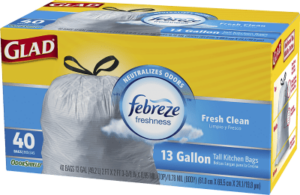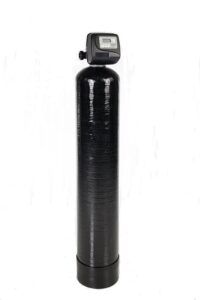We’ve all seen the antibacterial designation on hand and dish soaps. You may even have seen the same on packages of shower curtain liners or athletic wear. But what does this mean? To the company who produced the product, it means that antimicrobial agents have been impregnated into the fibres or substance of the product as a selling feature. To many people, it means that the product will withstand regular use longer without beginning to smell or collect scum. To someone who is allergic to antibacterial agents like isothiazolinones, it means danger.

Source: www.glad.com
I posted several months ago about the addition of fragrance to garbage bags and how this practice can affect those who are sensitive or allergic to fragrances. The fragrance molecules are impregnated into the bags in such a way as to be exposed to the air so that the fragrance can overpower and reduce the smell of garbage. Likewise, the addition of antimicrobial agents to clothing and other products means that these chemicals are added into the manufacturing process in such a way that they are on the outer surface of the fibre, or the contact surface with the outside/inside world.
Recently on Facebook a group member posted a link to a company promoting to manufacturers the use of their isothiazolinone products in various consumer goods. I am not going to link to the product, because I don’t want to give them extra traffic. The products listed on the website were extensive in scope: Tents, athletic shoes, filters, mattresses, carpets, fabrics, and more. Most of these products we don’t think about having antimicrobial treatments, or we haven’t considered the consequences or nature of the antimicrobial action. Although often this treatment is a selling feature, how many people have been sold by the words, “Odour-Reducing Technology,” or the like, without questioning further? How many products don’t clearly advertise this treatment?

Source: www.dialsoap.com
These “chemically enhanced” products are harmful to people with allergies to the antimicrobial chemicals used, and can help to create sensitivities in people who are not currently affected. This is important. These chemicals are sensitizers, meaning that repeated and prolonged exposure can cause sensitivity and make existing sensitivities worse. Isothiazolinones are already in almost every water-containing consumer product; most people are exposed to small-to-medium amounts all day every day. Exposure to these chemicals doesn’t just occur through direct physical contact, but also through contact with contaminated air. This brings up further concern when treating items like carpets, mattresses, and filters, as air or water that passes through those filters, and air that gets stirred up when people walk across those carpets or lay on beds are equally hazardous. What makes this even worse is that this “added feature” isn’t needed. Filters and mattresses didn’t make us sick before (when used correctly). They don’t need this treatment, and neither do we.

Chlorine Removal Backwater Filter – http://www.cwwltd.com/
What can you do? Read product information thoroughly. Question claims about how a product reduces odours or inhibits microbial growth. Contact companies, ask questions, and express your concerns. Educate others about the hazards of these sensitizing chemicals. Contact your government to lobby for the reduction of use of these chemicals. Seek out products that do not have these treatments. Consider natural alternatives. For example, wool and hemp are naturally antimicrobial, which is why there has been an increase of the use of wool in workout wear. You can buy water filters that don’t use cartridges. Consider canvas tents – they come in styles and sizes ranging from 2 person right up through 30 person and more. Buying less expensive shoes and workout wear may actually help, as manufacturers are unwilling to put extra materials (in this case chemicals) into products with smaller profit margins.
If enough consumers vote with their feet, manufacturers will get the message and at least provide alternatives. This is going to take education. Consumers need to understand the risks so that they can make a conscious decision instead of blindly choosing products. Share this information with your friends and family. Tell the world. Let’s make this known, and push back at manufacturers and chemical companies (says the person who once worked for a chemical company). Be conscientious, everyone!
